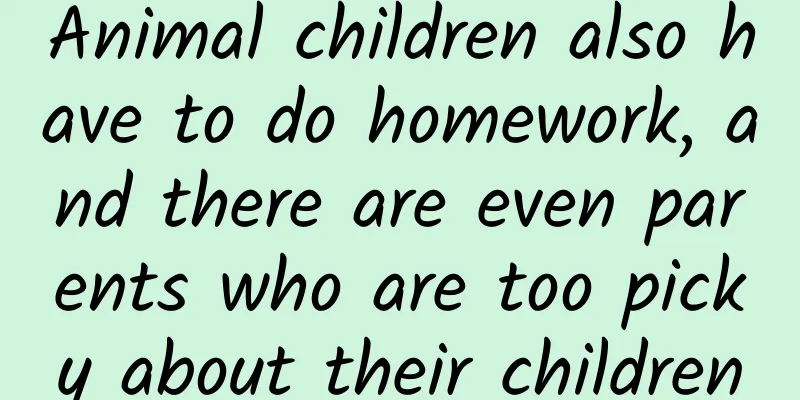Animal children also have to do homework, and there are even parents who are too picky about their children

|
When you don’t want to go to school or work, have you ever envied the life of animals - eating, drinking and sleeping every day, without having to take exams, work overtime or do homework? However, if meerkats knew that humans have such thoughts, they would definitely jump out and loudly object: animals’ children also have to do homework and have to endure the “torture” of their parents tutoring them in homework! "Are you talking about me?" | Jamain / Wikimedia Commons Meerkats (Suricata suricatta) are the trouble-making Timon in The Lion King. Alex Thornton and Katherine McAuliffe of the Department of Zoology at the University of Cambridge found that meerkats give children "homework" - live scorpions, and supervise them to complete it. 01 Meerkat's Course Meerkats are social animals, and most of the cubs in the group are born by the highest-ranking couple, and the rest of the adults help take care of the children. When the young meerkats follow the adults to forage, they will use special calls to ask the big meerkats for food, and all the big meerkats in the group will give them the insects, scorpions, etc. they catch. If the cub is still very small, the meerkat will bite the prey to death and give it to the cub. As the cub grows older, the meerkat will give more and more live prey, making the "task" facing the child more difficult. The most dangerous prey faced by meerkats is scorpions. Scorpions of the genus Parabuthus are enough to poison a person. For safety, the meerkat will bite off the scorpion's sting and give it to the cub. When the meerkats are handling their prey, the adult meerkats are responsible for supervision and will catch the insects as soon as they run away. If the baby meerkats do not catch them, the adult meerkats will use their noses to push the insects, as if urging the children to "hurry up." The standard for determining the "teaching progress" of meerkats is very simple. If they hear the cries of very young meerkats, the adult meerkats will give them dead insects, and if they hear the cries of older meerkats, they will give them live insects. Therefore, meerkats do not need high intelligence to gradually let the little meerkats practice hunting skills, and avoid the risk of being stung by scorpions. A baby meerkat follows a large meerkat that has caught a scorpion for food | national geographic Meerkats are very special in the animal world because they embody an example of teaching. Teaching is extremely rare among animals and was once thought to be a phenomenon unique to humans. You may loudly refute me, don't animals learn? Some animals even have "culture" - skills learned by members of the group and passed down from generation to generation. But please bear with me, animals can learn, but it does not mean that animals can teach. 02 Animals don't want to go to class Many animals can obtain information from their own kind, but they rarely take the initiative to "learn" or "be taught". Instead, they learn imperceptibly in a social environment (inadvertent social learning). A famous example of animal learning occurred on Koshima Island in the middle of the last century, where Japanese macaques (Macaca fuscata) "invented" a new way to eat sweet potatoes: they used water to wash off the sand to avoid it getting on their teeth. Although more and more monkeys have learned to wash sweet potatoes, the speed of transmission of sweet potato washing in the monkey group remains basically unchanged. If monkeys actively learn from other monkeys, the more monkeys who can wash sweet potatoes, the faster the cultural transmission should be - but in fact, the speed of transmission of this skill in the monkey group remains basically unchanged, indicating that the monkeys are not actively learning. When seeing their peers put sweet potatoes in water, monkeys may become interested in sweet potatoes and water, and fiddle with them themselves, thus discovering the benefits of washing sweet potatoes; but they will not actively teach or learn this skill. Monkeys washing sweet potatoes | Hirata et al. / Springer, Tokyo (2008) To understand whether there are teachers in animals, we must first clarify what is considered teaching. TM Caro and MD Hauser of the University of California define the act of "teaching" as follows: 1. Individual A (teacher) exhibits teaching behavior only when individual B (student) is present. 2. A’s behavior is harmful to A or has no immediate benefit. 3. A's behavior encourages or prevents B's behavior, or provides experience for B, or sets a good example for B. 4. Due to A's behavior, B can master certain knowledge or skills faster or more effectively. Therefore, it can be seen that monkeys are not teaching other monkeys when they wash sweet potatoes, because they are washing them for themselves to eat. An ant with the scientific name Temnothorax alpipennis is an example of an animal taking classes: after an ant finds food, it will lead the way to its companions. The leading ant always keeps antennae in contact with the following ants, so it runs slower (a disadvantage), but the following ants can remember the way to the food (knowledge) and will not lose it. Ants lead their companions to forage for food | Ellouise Leadbeater et al. / Current biology: CB (2006) Bees use waggle dance (also called figure 8 dance) to convey the information of "where is nectar" to their peers. It is well known to animal behaviorists, and few people think it is teaching. But from another perspective, the dance of bees is not good for them, and tells other bees some useful information, which also meets the definition of teaching. 03 Do orangutans also need to take exams? Here’s a curious fact: We’ve found teaching in distantly related animals (meerkats and ants), but we haven’t found examples of teaching in the primates that are most similar to us. Primates need to learn many survival skills, and organizations that protect wild primates even give orangutans “lessons” to teach them to identify edible plants, avoid snakes, and so on, but orangutans don’t teach their own children. A team led by William JE Hoppitt of the University of St Andrews believes that teaching is rare in animals, and the few animals that can teach are not related to each other. This may be because special conditions are required to evolve the ability to "teach". Orangutan mother and child | Pixabay First of all, we say that teachers are "red candles" and "gardeners". Although the level of teachers varies, in many cases, teaching requires teachers to pay some price, and the students are the ones who benefit. In zoology, the behavior of sacrificing oneself for others is called altruism. Altruism generally occurs in groups with close relatives, such as social insects such as ants and bees. Helping relatives is also beneficial to the continuation of their own genes. This can also explain why ants teach. Secondly, for teaching to evolve, its efficiency must be better than other learning methods. Many animals can learn enough survival knowledge through subtle influence, so they do not need teaching. In large apes such as orangutans and chimpanzees, children watch their mothers' activities for a long time and have many opportunities to learn. They do not need "chicken parents" to teach them. Only homeless orangutan orphans need human teaching. Counseling children is physically and mentally exhausting (not) | Böhringer Friedrich / Wikimedia Commons But meerkats are different. It is difficult for meerkats to catch prey by themselves. Adult meerkats eat insects very quickly, so they don’t have many opportunities to observe prey. If they encounter scorpions, their lives are in danger. Therefore, the meerkats need adult meerkats to give them “homework”. Many complex skills of humans cannot be learned by just watching. Therefore, humans, independent of meerkats and ants, have once again produced teaching behavior, which has also produced endless spiritual wealth and spiritual torture. This also guides us to break away from the single perspective of human beings and look at teaching with a more tolerant eye. Teaching is not a skill unique to humans, nor is it a manifestation of advanced wisdom. When the necessary conditions are met, it will appear. Author: Little Wombat Editor: pee pee shrimp References [1] Hoppitt, William JE, et al. "Lessons from animal teaching." Trends in ecology & evolution 23.9 (2008): 486-493. [2] Thornton, Alex, and Katherine McAuliffe. "Teaching in wild meerkats." Science 313.5784 (2006): 227-229. This article comes from the Species Calendar, welcome to forward If you need to reprint, please contact [email protected] |
<<: Has the former overlord of the earth really been served on our dining table?
>>: Will the epidemic affect human psychology for 20 years? Experts say so...
Recommend
Terrible! It’s better to throw away these parts of the pig than to eat them (not just the lymph nodes)
Pork can be said to be one of the most common ing...
What happened to the BeiDou-3 global satellite navigation system? What is the specific situation?
July 31, 2020 is a big day worth remembering for ...
After the college entrance examination, be careful of the hidden things in seafood
After the college entrance examination, you can r...
The way to fine-tune APP operations: "users + push" of data
There are too many apps to choose from on the mar...
Online event promotion, increased 100,000 users in seven days!
What kind of event can enable a beauty store to g...
What is the investment price of Benxi used car mini program? Benxi second-hand car mini program investment price inquiry
How much does it cost to attract investment throu...
Review: Sharing of event operation planning process
Operational activities are one of the common meth...
Build a training camp SOP from 0-1!
Training camp is one of the projects I have manag...
Your Guide to YouTube Video Ad Formats for 2020!
Video marketing and brand promotion through YouTu...
Jidu and Hesai Technology reached a strategic cooperation
Jidu is a technology startup dedicated to creatin...
Why is seafood not tasty when it’s dead? For tips on choosing seafood, just read this article!
Friends who have bought seafood know that after f...
How much does it cost to customize the Xiangyang fabric mini program?
There are two types of customization for Xiangyan...
Misconception! 5 common misunderstandings about information flow advertising image materials, with 4 guidelines + 2 cases attached!
Introduction: This article lists five major color...
Acupuncture: Jiao Shunfa ~ Jiao's Head Acupuncture Training Course HD Video 14.64G including courseware
Acupuncture: Jiao Shunfa ~ Jiao's Head Acupun...









